DLPA117A October 2020 – February 2021 DLP3030-Q1 , DLP4620S-Q1 , DLP5530-Q1 , DLP5530S-Q1 , DLPC120-Q1 , DLPC230-Q1
Technical White Paper
Augmented-reality head-up displays (AR HUDs) have the potential to further enhance user experience and safety while driving. Because AR HUDs combine a virtual image (AR information) with the real world, they need a wide field of view (FOV) and a long virtual image distance (VID).
A longer VID can result in a better driving experience and a lower cost AR HUD system. In this white paper, we discuss physiological distance cues to explain why human eyes experience less fatigue when looking at objects farther away, how a longer VID can reduce the parallax effect, and how a longer VID can enable designers to save costs by eliminating eye-tracking systems and wedge films.
Physiological distance cues
Eye accommodation is the process where the human eye adjusts the focal length of its lens to have a focused image of the object at the retina surface depending on the distance of the object. The ciliary muscle and suspensory ligament need to contract or relax the lens of the eyes to adjust the focal length, as shown in Figure 1-1. To see an object that is close by, the ciliary muscle needs to contract to make the lens rounder, giving the eye a shorter focal length. To see an object farther away, the lens needs be flatter to have a longer focal length.
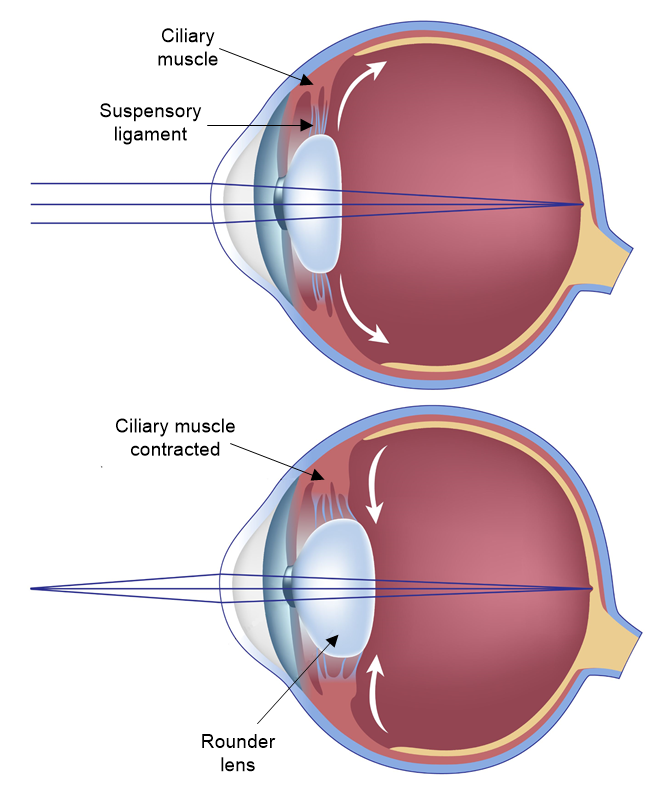 Figure 1-1 Eye Accomodation
Figure 1-1 Eye AccomodationFigure 1-2 graphs the change in focal length versus the distance of an object.
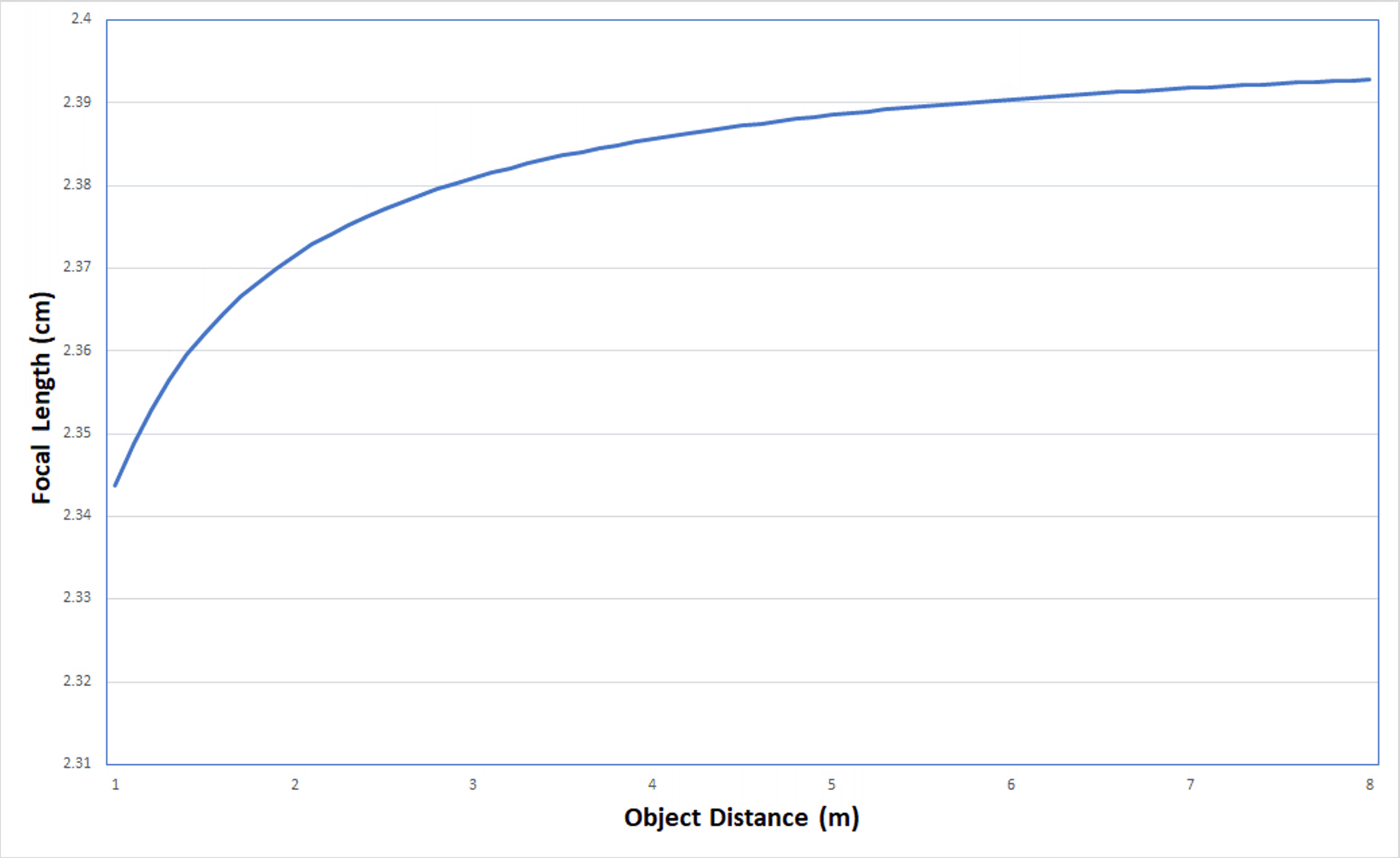 Figure 1-2 Lens of Human Eyes Focal
Length in Centimeters vs. the Object Distance in Meters
Figure 1-2 Lens of Human Eyes Focal
Length in Centimeters vs. the Object Distance in Meters As Figure 1-2 illustrates, the eyes will be relaxed (and thus less fatigued) when the object distance is 6 m or more. In normal driving conditions, a driver’s eyes focus at distances much farther away than 6 m. If the HUD information is located at a shorter distance (such as 2 m in traditional HUDs), the eyes need to make adjustments to focus on HUD information and real-world objects. Such adjustments can lead to eye fatigue and a poor driving experience.
Eye convergence is the act of rotating the eyes to focus on an object, as shown in Figure 1-3. Objects that are closer require the eyes to rotate more inward, also causing eye fatigue. When focusing on objects that are farther away, the eyes remain more parallel and require less muscle strain to align with the object. The farther the object distance, the less muscle movement required.
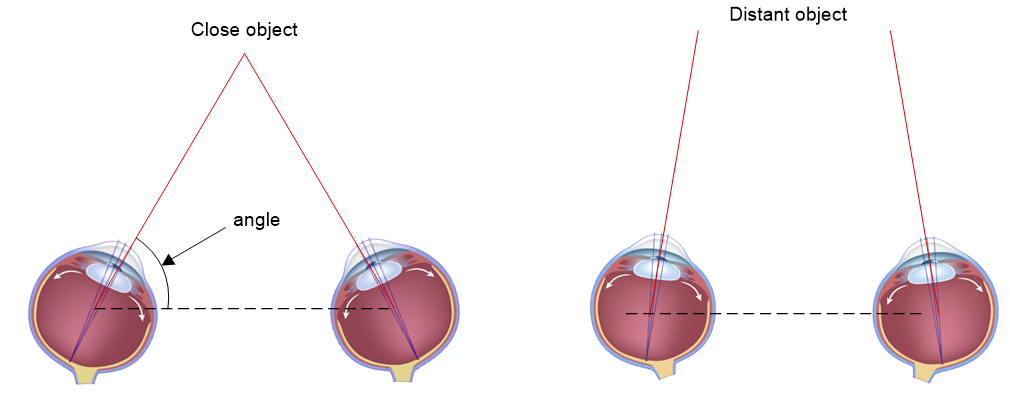 Figure 1-3 Eye Convergence
Figure 1-3 Eye ConvergenceFigure 1-4 graphs the angle of eye rotation versus the object distance.
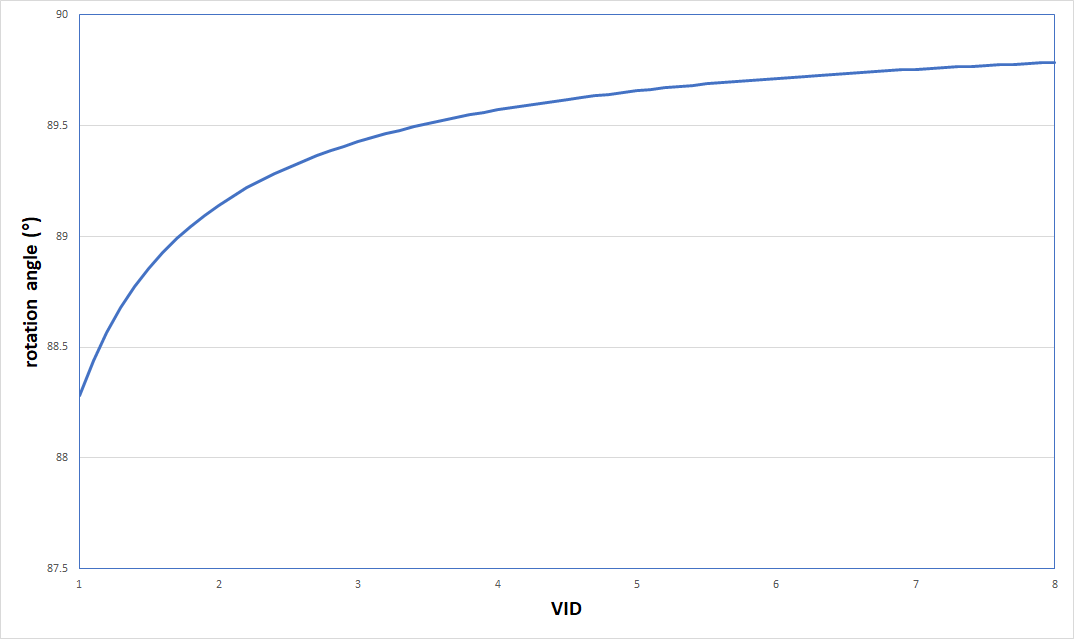 Figure 1-4 Eye Rotation Angle in Degrees
vs. the Object Distance in Meters
Figure 1-4 Eye Rotation Angle in Degrees
vs. the Object Distance in MetersThe distance of an object also affects the fusion of AR information to the real world. When the VID is greater than 6 m, the eyes are less sensitive to discrepancies in physiological distance cues and will perceive that the AR information is more strongly fused with the real world. Thus, a VID longer than 6 m is necessary for a good user experience.
The Parallax Effect
Parallax is a displacement or difference in the apparent position of an object viewed along two different lines of sight. Parallax is the change of alignment of the virtual image and the real-world object when the human eye changes position.
Figure 1-5 shows two examples where the virtual images and the real-world objects are perfectly aligned while the driver’s eyes are in the intended position. The virtual images are located at 2 m and 13 m. Figure 1-5 (a) and (c) are perspectives from above showing the locations of the virtual images and real-world objects. Figure 1-5 (b) and (d) show the driver’s perspective. The red and blue rectangular blocks in both Figure 1-5 (b) and (d) are well aligned with the pedestrian and the car in front of the driver even though the VIDs are very different.
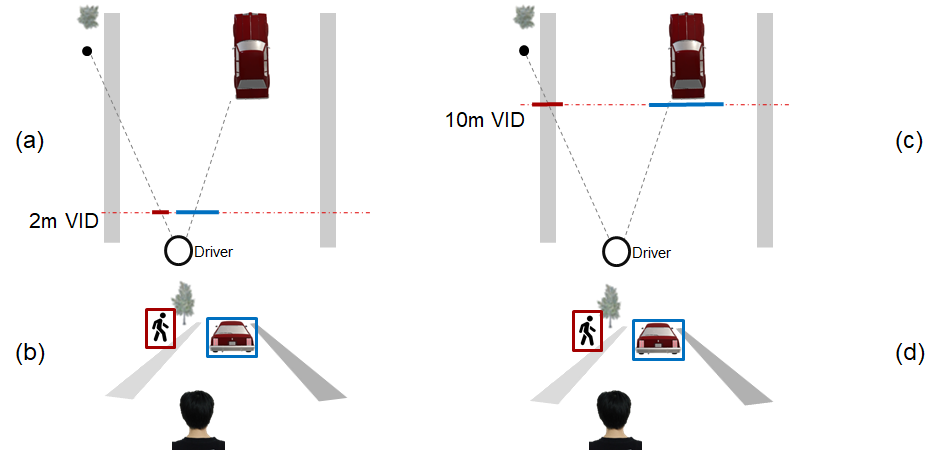 Figure 1-5 Alignment of Virtual Images
and Real-World Objects
Figure 1-5 Alignment of Virtual Images
and Real-World ObjectsFigure 1-6 illustrates what happens when the driver moves their head slightly to the left. The red and blue rectangles will also move because of the parallax effect, resulting in a misalignment of the virtual images and real-world objects. However, there is a large difference in the degree of misalignment between the 2m and 13m VID cases. In the 2-m VID case, depicted in Figure 1-6 (b), the red and blue rectangles have moved completely out of the intended alignment with the pedestrian and car due to the short VID. The misalignment in the 13-m VID case is much smaller and not as noticeable due to the longer VID, as depicted in Figure 1-6 (d).
 Figure 1-6 Alignment of Virtual Image and
Real-World Objects when the Driver Moves Their Head Slightly to the Left
Figure 1-6 Alignment of Virtual Image and
Real-World Objects when the Driver Moves Their Head Slightly to the LeftIt is possible to calculate this misalignment. Figure 1-7 shows the magnitude of misalignment of the virtual image and real-world object, where D is the distance of the real-world object, Δeye is the change in eye position and ∆image is the change of the virtual image position at the target distance, D. For a 2-m VID, if the real-world object is at a distance of 25 m (D = 25 m) and the eye position changes by 10 cm, the virtual image position will move by 1.2 m, which is significant enough to see an obvious misalignment. For a 13-m VID, the same change in eye position will result in only a 10-cm change in virtual image position, which is negligible.
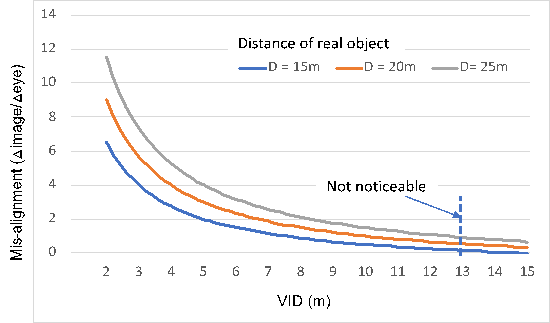 Figure 1-7 Misalignment (Δimage) of the
Virtual Image and the Real-World Object at Distance D Caused by Eye Position
Change (Δeye). The Misalignment Decreases as the VID Increases
Figure 1-7 Misalignment (Δimage) of the
Virtual Image and the Real-World Object at Distance D Caused by Eye Position
Change (Δeye). The Misalignment Decreases as the VID IncreasesEye Tracking
Automotive designers often implement eye tracking in order to eliminate the parallax effect for short VID HUD systems. Such systems, however, can not only increase system costs and R&D effort, but can also result in a poor user experience given the latency between the head movement and the virtual image adjustment.
Eliminating eye tracking can simplify the graphic rendering of the human machine interface as well as the load on the graphic processor. A longer VID (10 m to 15 m) reduces the parallax effect and makes it simpler to maintain the alignment of virtual images to the real world.
Wedge Film
HUD systems with a short VID and standard windshield glass produce a double image caused by reflections from both the top and the bottom surfaces of the windshield glass. A wedge film in the windshield glass helps eliminate the double image.
Figure 1-8 illustrates how the windshield glass creates a double image. The light of the HUD image is projected to the windshield at an angle of to the normal line. The red solid line is the first reflection off the bottom surface. The refraction light of the image has an angle of and is reflected when reaching the top surface of the windshield. The red dashed line shows the image caused by the second reflection.
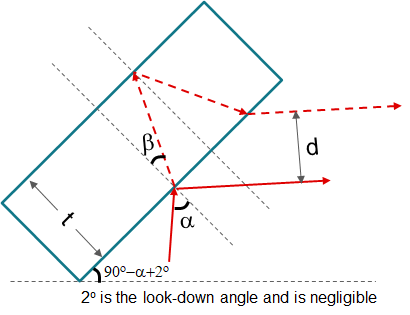 Figure 1-8 Illustration of the Double
Image Created by the Two Reflections
Figure 1-8 Illustration of the Double
Image Created by the Two ReflectionsEquation 1 calculates the displacement, d, of the two images:
where t is the thickness of the glass
Equation 2 expresses the relationship between α and β:
where n is the refraction index of glass, which is approximately 1.5
The reflected light typically has a small look-down angle (the angle between the light line and the horizon) such as 2 degrees, but we will neglect this angle to simplify the calculations. Using = 60 degrees and t = 5.5 mm as an example, the calculations result in = 35.3 degrees and d = 3.9 mm.
Although the linear displacement of the two images remains constant and independent of the VID, the angular displacement is dependent on VID. The two images in Figure 1-8 are always 3.9 mm apart from each other, regardless of the VID. When the two images are close to the driver, the double image is easily distinguishable. As the two images move further away from the driver – that is, at a longer VID – the double image will be less distinguishable. As the VID increases, the same 3.9 mm will have less angular displacement.
Converting from linear displacement to angular displacement for the two images, Equation 3 calculates the displacement angle as:
For typical human vision, the angular resolution is 1 arc minute, or one-sixtieth of a degree. Most displays use 60 pixels per degree (ppd) as a criterion for display resolution. When the angle given by Equation 3 is less than one-sixtieth of a degree, the double image is no longer visible to the driver.
The displacement angle can also be converted into a number of pixels with Equation 4, assuming that the resolution is 60 ppd:
Figure 1-9 graphs the relationship between the number of pixels and the VID, where the thickness of the glass (t) is assumed to be 5.5 mm. When = 60 degrees (or the slope of the windshield is approximately 30 degrees), the displacement of the double image is 1 pixel (1/60 of a degree) when the VID is 13 m, which is the limit of typical human vision resolution.
Therefore, when the VID is longer than 13 m, there is no need for a wedge film to remove the double image. Using a longer VID makes it possible to potentially eliminate the wedge film, reducing system complexity and cost.
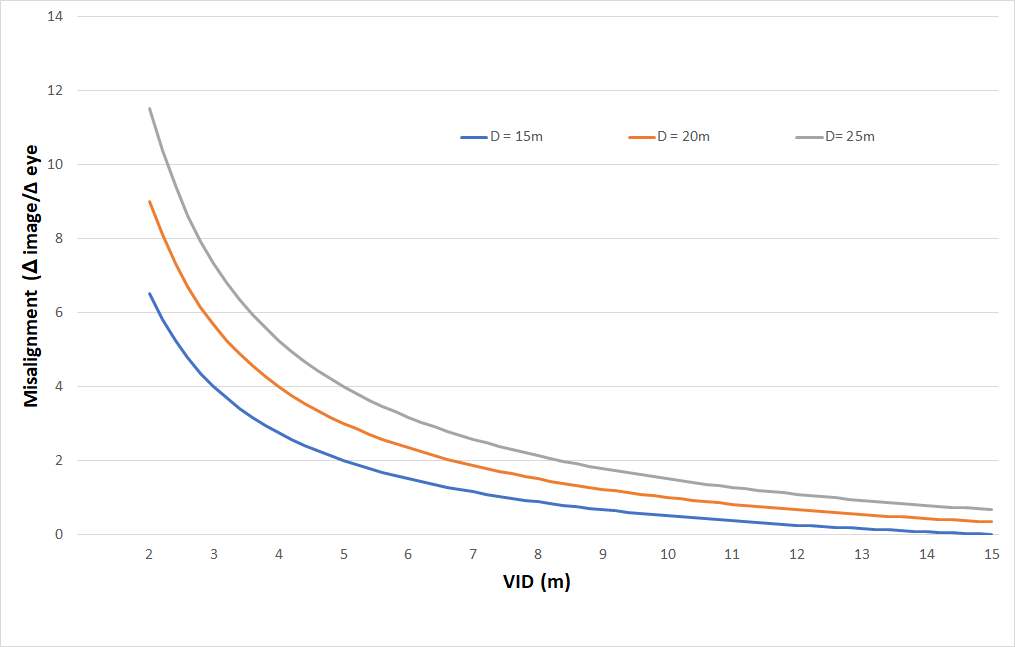 Figure 1-9 The Displacement of the Two
Images by Pixel Number when the Resolution is at 60 ppd
Figure 1-9 The Displacement of the Two
Images by Pixel Number when the Resolution is at 60 ppdConclusion
A longer VID in an AR HUD system can result in a better user experience and lower system cost. A longer VID will result in less eye fatigue, a negligible parallax effect when the driver moves their head or eyes, better fusion between AR information and real-world objects, and the elimination of wedge film and eye-tracking requirements.
The optimal VID is between 12 m and 15 m. This VID range makes it possible to fuse virtual images with the real world. The benefit diminishes if the VID increases beyond this recommended range.
A longer VID does negatively impact HUD systems with traditional optical designs, however, by creating a solar load challenge. The white paper, DLP® Technology: Solar Loading in Augmented Reality Head-Up Display Systems, has a detailed discussion on solar load challenges in HUD designs. HUDs adopting DLP technology can tolerate much higher solar loads and enable long VIDs without any thermal issues.